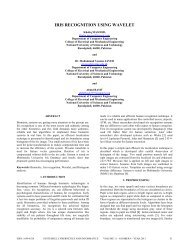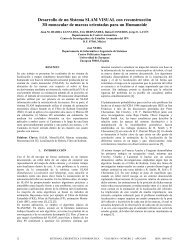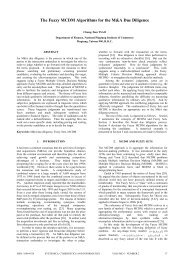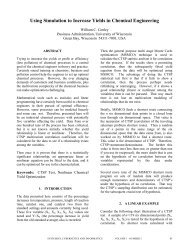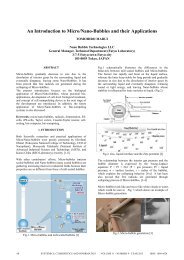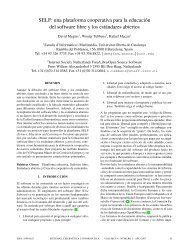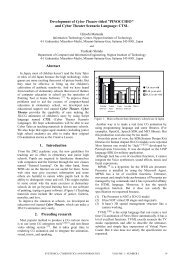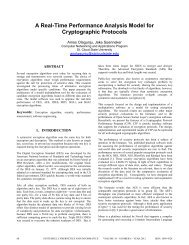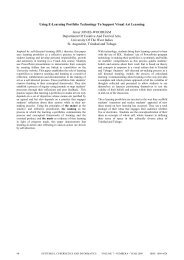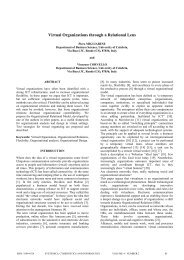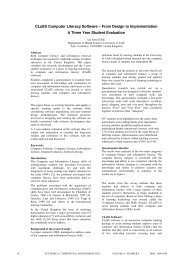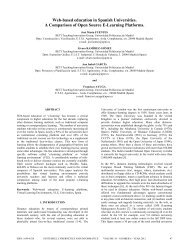A DoS/DDoS Attack Detection System Using Chi-Square Statistic ...
A DoS/DDoS Attack Detection System Using Chi-Square Statistic ...
A DoS/DDoS Attack Detection System Using Chi-Square Statistic ...
Create successful ePaper yourself
Turn your PDF publications into a flip-book with our unique Google optimized e-Paper software.
n−1<br />
n−1<br />
2 Ni−count<br />
− Gi −count<br />
x<br />
count<br />
= , and 2 Ni−count<br />
− Gi −count<br />
∑ x<br />
count<br />
= ∑<br />
i= 0 Gi −count<br />
i= 0 Gi −count<br />
where Ni−count<br />
( Ni−size)<br />
is number of packets (accumulated<br />
packet size) that group i has currently received in past 10 seconds,<br />
i=0,1,2,…12, n=13, and degree of freedom is df=12 (=n -1).<br />
In this research, we choose significant standard α = 0.05 and<br />
2<br />
x12, α<br />
= 21.026 . If x 2 ≤ x 2 , we accept the null hypothesis H ,<br />
12, α<br />
0<br />
indicating that there is no attack where x 2 may be either x 2 count or<br />
x 2 size. However, if 2 2 2 2<br />
x<br />
count<br />
> x (or<br />
12, α<br />
x<br />
size<br />
> x ) , we reject<br />
12, α<br />
H , which means its alternative hypothesis<br />
0<br />
H is true, showing<br />
1<br />
that there is a suspected resource consumption (bandwidth<br />
consumption) attack.<br />
Algorithm 3: detecting <strong>DoS</strong> attack by using chi-square statistic<br />
method invoked by an event analyzer for every ten<br />
seconds.<br />
Input: a source-IP distribution table T; baseline profile-count;<br />
baseline profile-size<br />
Output: whether or not a subnet or subnets protected by an event<br />
analyzer are under a <strong>DoS</strong>/D<strong>DoS</strong> attack<br />
{1. Att=false;<br />
2. If ( x 2 ( 2 count<br />
≥ x<br />
12, α<br />
+ threshold))<br />
/* a resource consumption<br />
attack is discovered */<br />
{For (i=0; i threshold )<br />
i−count<br />
Gi −count<br />
Choose k IPs whose past-10-sec-counts are the highest as<br />
the suspected hackers, where<br />
j= k−1<br />
m i −1<br />
∑ past −10 −sec −count / ∑ past −10 −sec−count<br />
j in<br />
j<br />
j= 0 j=<br />
0<br />
≥ 80%<br />
which m i is number of source IPs in group i;<br />
Send attack information to the black list database, and an<br />
alter message to administrator to show that there is a<br />
resource consumption <strong>DoS</strong>/D<strong>DoS</strong> attack;}<br />
3. If ( x 2 ( 2 size<br />
≥ x<br />
12, α<br />
+ threshold))<br />
/* a bandwidth consumption<br />
attack is discovered */<br />
{For (i=0; i threshold<br />
)<br />
i−size<br />
Gi−<br />
size<br />
Choose k IPs whose past-10-sec-sizes are the highest as<br />
the suspected hackers, where<br />
j= k−1<br />
m i −1<br />
∑ past−10 −sec −size / ∑ past−10 −sec−sizej<br />
;<br />
j<br />
j= 0 j=<br />
0<br />
≥ 80%<br />
Send attack information to the black list database, and an<br />
alter message to administrator to show that there is a<br />
resource consumption <strong>DoS</strong>/D<strong>DoS</strong> attack;}}<br />
An Event Collector<br />
As stated above, an event analyzer periodically, once per 10<br />
seconds, sends its source-IP distribution table to its event<br />
collector which on receiving the table, for each source IP address<br />
retrieves the corresponding count and size from the table, sums up<br />
the counts and sizes for each packet information subfield (a total<br />
of 10+10 subfields) and records the results in the corresponding<br />
subfields in its own source-IP accumulation table, which has the<br />
same schema as that of Table 1. In other words, the values of<br />
packet information subfields of a source IP address P appearing in<br />
different source-IP distribution tables will be summed up as total<br />
counts/sizes of the corresponding subfields of P in a source-IP<br />
accumulation table. For example, in the source-IP accumulation<br />
table, P’s past-i th -day-count is the sum of P’s past-i th -day-counts<br />
in all the received source-IP distribution tables,1≤i<br />
≤ 7.<br />
An event collector should receive source-IP distribution tables<br />
periodically from all its event analyzers. When it does not receive<br />
the table from an event analyzer, it dispatches a mobile agent as a<br />
backup agent to check status of the event analyzer. If the event<br />
analyzer is still alive, the backup agent asks the event analyzer to<br />
send the source-IP distribution table to the event collector.<br />
Otherwise, the backup agent will request the corresponding<br />
backup subsystem to select a host to take over for the failed event<br />
analyzer. The functions of the backup host are exactly the same as<br />
those of an event analyzer.<br />
An event collector detects whether a geographically concentrated<br />
unit is attacked by a <strong>DoS</strong>/D<strong>DoS</strong> or not also based on chi-square<br />
statistic approach. It calculates chi-square values of normal<br />
network traffic in advance for a geographically concentrated unit<br />
by using the algorithm similar to Algorithm 3 with the given<br />
source-IP distribution table substituted by its source-IP<br />
accumulation table. Its baseline profile values are also generated<br />
from the accumulation table beforehand. Each time, when an<br />
event collector finishes collecting source-IP distribution tables<br />
and updating its own source-IP accumulation table, of course<br />
once per 24 hours, it periodically once per 10 seconds checks to<br />
see whether the chi-square value of current network traffic for its<br />
13 groups significantly exceeds its threshold or not. If yes, it<br />
dispatches a mobile agent as a update agent to send hacker<br />
information to the black list database. And regardless of yes or<br />
not, it dispatches a mobile agent as a notifying agent to send its<br />
source-IP accumulation table, also per 10 seconds, to the duty<br />
center, which will integrate contents of source-IP accumulation<br />
tables delivered by all event collectors, into its source-IP<br />
integration table from which the duty center can further detect<br />
D<strong>DoS</strong> attacks, particularly for low-density <strong>DoS</strong>/D<strong>DoS</strong> attacks,<br />
which are hard to be detected by an event collector.<br />
Duty Center<br />
The duty center, as the coordinator of AIDS, further detects<br />
whether or not there is a <strong>DoS</strong>/D<strong>DoS</strong> attack which is attacking the<br />
protected system. The duty center builds a source-IP integration<br />
table, of which the table structure is similar to that of a source-IP<br />
distribution table, to detect attacks. If yes, the duty center<br />
dispatches a mobile agent to record attackers’ information also in<br />
the black list database. With the database, a firewall can<br />
accordingly filter out packets issued by known hackers.<br />
Algorithm 4 shows the detection details of the duty center.<br />
Algorithm 4: process of the duty center<br />
Input: source-IP accumulation tables received periodically<br />
Output: whether network management unit, e.g., a<br />
university/company, is under a D<strong>DoS</strong> attack<br />
{1. If (timer generated for an event collector times out)<br />
{Dispatches a mobile agent as a backup agent to check status<br />
of event collector;<br />
If (event collector fails)<br />
Send a message to the corresponding backup subsystem<br />
to choose a host to take over for the failed event collector;<br />
46 SYSTEMICS, CYBERNETICS AND INFORMATICS VOLUME 8 - NUMBER 2 - YEAR 2010 ISSN: 1690-4524



